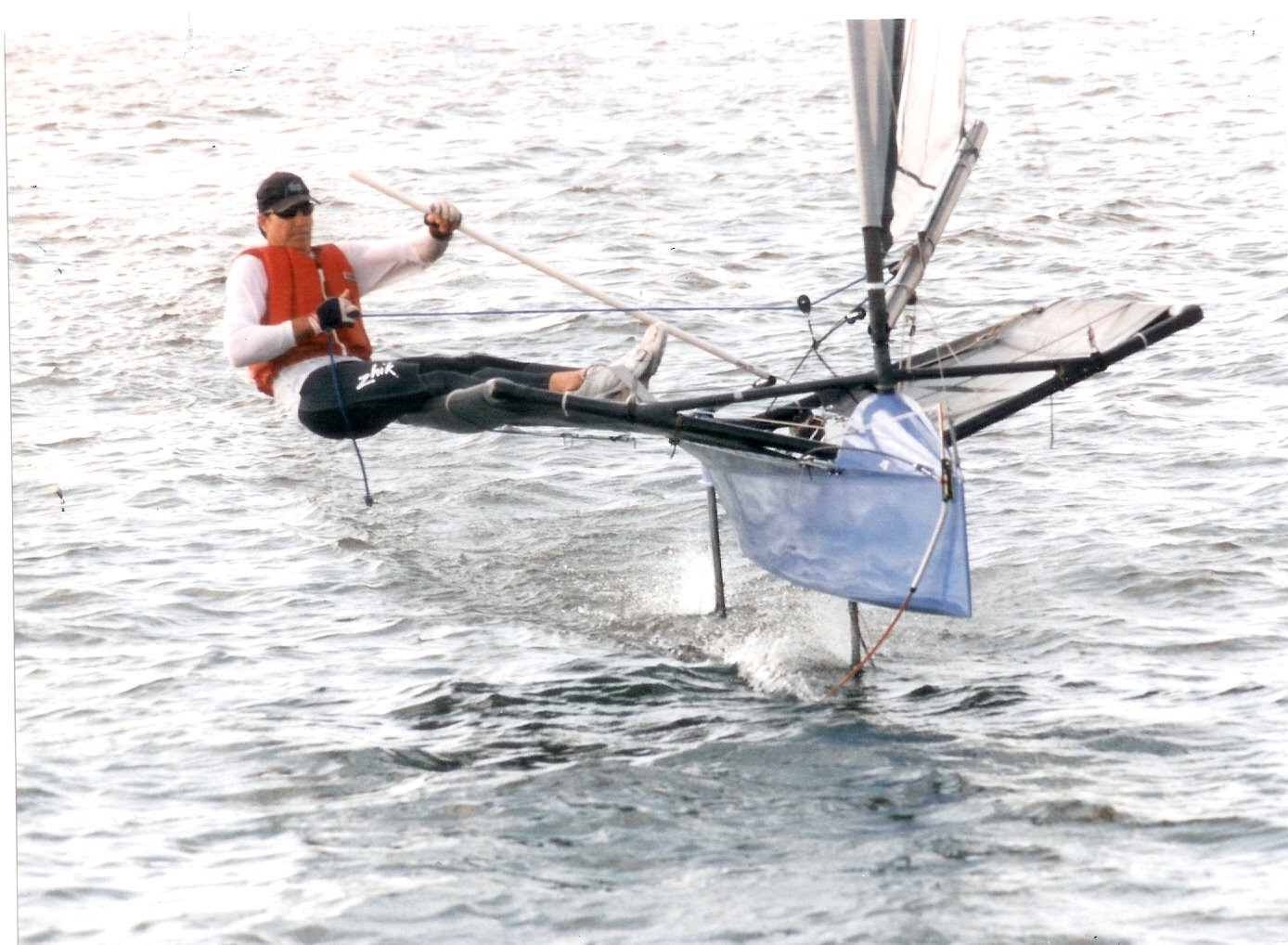"So how can I design a design failure location into my gantry? Add a Shear pin to would release the bottom gudgeon at the pin? The strut and cassette assembly would fly up. 8^( Would this still break nearly everything? Add a SS pivot at the top? Release the bottom gudgeon at the stern? The whole gantry would fly up......."
...and re-reading Dan's report on two exploding gantries at the Gorge, I thought I'd chime in on my experience and observations. When I built my first rudder system I was following Bill's lead with his added admonition to beef up the cassette since he had experienced the rudder ripping out the back wall of his cassette. My resulting system was successful in that in occurred no failures (even at the heavy air of the Weymouth Worlds.) The pictures below and to the right was taken in the spring of '08 during the second or third time out. Obviously the boat is flying fine, albeit a little low. This was with both the mainfoil and rudder foil as non-production elements, built by me with lots of assistance from Gui and Bill (using their molds and employing their expertise on laminate schedules, etc.)
Clicking on the image above will bring up the original image size and the gantry can be seen more clearly. This gantry and rudder have since retired to the spare parts bin.
During the winter of '08/'09 I re-designed the rudder system to lose some of the mass and play (no cassette, just a vertical with gudgeons), incorporate an improved worm gear, and to feature a forward cant angle similar to the M2's geometry. I built a new strut using John Z.'s skinny vertical section (the low drag winner in Bill's tank tests) and fitted a much smaller Beiker-designed/Bora-built horizontal (that I got just a few days before packing up for the '09 Worlds.) The horizontal and vertical sections seem to work well, and in fact the horizontal is near the size that's currently in vogue - the span is only 775mm, approaching that of the new M2 "small rudder." So with an improved adjustment system and a new, but not tested rudder and gantry, I went to the Worlds in Oregon. Unfortunately, the gantry decided to come apart not once, but twice. The culprit was the G10 plugs I inserted into the tube structure. Either due to poor surface preparation or insufficient contact area, or both, one of the inserts came out (probably the lower tension member) and caused a cascade of failures. Adam snapped a pic of me swimming back in and I commented about the fiasco in this post.
I did repair the gantry and sailed the rest of the season with the "agricultural" - thanks Bear- setup without incident. This spring, in preparation for the NAs I decided to replace the gantry with a third version, keeping the geometry but losing the massive turnbuckle, the fairing (which never seemed to work as well as I hoped), and incorporating a different pin adjustment system as suggested by Phil Stevenson in this post. The tiller and swivel system was completed and works way better than the old set-up, but I wasn't quite able to finish the gantry. Nevertheless, the rudder system was in the best shape since the boat was built. So, of course this season's failure wasn't the rudder but the mainfoil, occurring during the first race of the NA series (why didn't it happen during the almost four weeks of daily practice leading up to the trip to Harbor Springs?)
At any rate, the third gantry is just about complete. The geometry has a slightly wider top base, with the top attachments fitting around some beefed up G10 tangs instead of employing any inserts. The lower tension member has just a threaded barrel that accepts the male clevis for gross adjustment. The female barrel is embedded such that it can't come out. I've retained the triangulation joints and I believe that they are way beefier than required. The bushings for the 1/4" ss rod are made of 1.25" long delrin, turned so that they require a press fit into the vertical tube (and definitely not capable of vibrating out.)
So what do I think would happen if I ran aground at speed? My rudder vertical is about a long as the mainfoil strut so any forces should be taken by the mainfoil and centerboard well. If for some reason I hit a log that missed the mainfoil I would expect the boat to stop suddenly and damage would be taken by either the lower gudgeon on the rudder (it happened once at the Gorge on the 2nd to last day) or to the aluminum plate on the hull, perhaps ripping out through the transom (unlikely.) The point of this whole post is that I think one should not design a failure point, but just build the whole kit and kaboddle sufficiently strong so it won't break. Wishful thinking, I know, but why anticipate failure when anticipating a perfect build is so much more rewarding?



1 comment:
Hi Joe,
I totally agree with you... sod building in failure points... A boat should not break and that includes the gantry. I've found that in my first season of competition, I've managed to clock up some decent results based purely on the fact that the boat held together where others didn't.
I think moths have historically been under engineered for the sake of saving a few grams. Better built = completed regattas!
Cheers,
Phil
Post a Comment